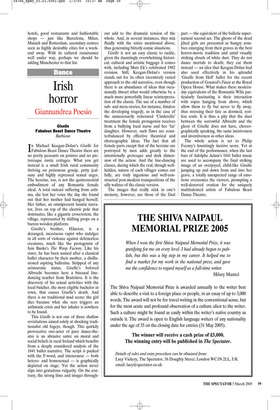Irish horror
Giannandrea Poesio
Giselle Fabulous Beast Dance Theatre Barbican In Michael Keegan-Dolan’s Giselle for Fabulous Beast Dance Theatre there are no pretty peasants on pointes and no picturesque rustic cottages. What you get instead is a small Irish rural community thriving on poisonous gossip, petty jealousy and highly repressed sexual urges. The heroine, too, is not the quintessential embodiment of any Romantic female ideal. A total outcast suffering from asthma, she lost her voice the day she found out that her mother had hanged herself. Her father, an omnipresent lunatic narrator, lives on top of the electric pole that dominates, like a gigantic cross/totem, the village, represented by shifting props on a barren wooden platform.
Giselle’s brother, Hilarion, is a deranged, incestuous rapist who indulges in all sorts of violence against defenceless creatures, much like the protagonist of Iain Banks’s The Wasp Factory. Like his sister, he has been named after a classical ballet character by their mother, a disillusioned aspiring ballerina. Stripped of any aristocratic status, Giselle’s beloved Albrecht becomes here a bisexual linedancing teacher from Bratislava. It is the discovery of his sexual activities with the local butcher, the most eligible bachelor in town, that causes Giselle’s death. And there is no traditional mad scene; the girl dies because what she sees triggers an asthmatic crisis and her inhaler is nowhere to be found.
This Giselle is not one of those shallow revisitations aimed solely at shocking traditionalist old fogeys, though. This quirkily provocative one-acter of pure dance-theatre is an abrasive satire on moral and social beliefs in rural Ireland which benefits from a deeply considered analysis of the 1841 ballet narrative. The script is packed with the F-word, and intercourse — both heteroand homosexual — is graphically depicted on stage. Yet the action never slips into gratuitous vulgarity. On the contrary, the strong lines and images through out add to the dramatic tension of the whole. And, in several instances, they mix fluidly with the satire mentioned above, thus generating bitterly comic situations.
Giselle is not an easy classic to tackle, given the dauntingly overwhelming historical, cultural and artistic baggage it comes with, including Mats Ek’s celebrated 1982 revision. Still, Keegan-Dolan’s version stands out for its often inventively varied approach to the old narrative, even though there is an abundance of ideas that occasionally thwart what would otherwise be a much more powerfully linear reinterpretation of the classic. The use of a number of suband meta-stories, for instance, hinders the developing tragedy, as in the case of the unnecessarily reiterated ‘Cinderella’ treatment the female protagonist receives from a bullying local nurse and her ‘fat’ daughter. However, such flaws are counterbalanced by effective theatrical and choreographic ideas. The fact that all female parts except that of the heroine are portrayed by men adds greatly to the intentionally grotesque and dark dimension of the action. And the line-dancing classes, during which the real, though wellhidden, nature of each villager comes out fully, are truly ingenious and well-constructed post-modern transpositions of the silly waltzes of the classic version.
The images that really stick in one’s memory, however, are those of the final part — the equivalent of the balletic supernatural second act. The ghosts of the dead jilted girls are presented as hungry zombies emerging from their graves in the best horror-movie tradition and amid visually striking clouds of white dust. They do not dance mortals to death; they eat them instead — an idea that Keegan-Dolan had also used effectively in his splendid ‘Giselle from Hell’ ballet for the recent production of Gounod’s Faust at the Royal Opera House. What makes these modernday equivalents of the Romantic Wilis particularly fascinating is their interaction with ropes hanging from above, which allow them to fly but never to fly away, thus stressing their fate as doomed, restless souls. It is thus a pity that the duet between the sorrowful Albrecht and the ghost of Giselle does not have, choreographically speaking, the same incisiveness and inventiveness as other ideas.
The whole action is set to Philip Feeney’s hauntingly incisive score. Yet at the end of the performance, when the last bars of Adolphe Adam’s 1841 ballet music are used to accompany the final striking image of an overjoyed, child-like Giselle jumping up and down from and into her grave, a totally unexpected range of emotions overcomes the viewers, prompting a well-deserved ovation for the uniquely multitalented artists of Fabulous Beast Dance Theatre.


























































 Previous page
Previous page